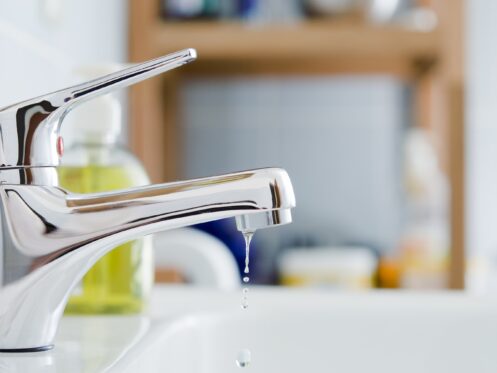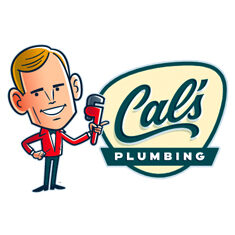Faucets are essential fixtures in every home, allowing us to use running water for household activities. However, faucets undergo so much routine usage that they can develop issues over time. From persistent drips to low water pressure and strange noises, these common problems can be annoying and disruptive. Fortunately, most faucet issues can be fixed efficiently and quickly by a professional plumber. At Cal’s Plumbing in Tucson, AZ, we are happy to help our customers with their faucet issues and restore the fixture to excellent condition. Let’s look at some of the most common faucet problems we encounter and how we help homeowners troubleshoot them.
Understanding Faucet Anatomy
Understanding the anatomy of a faucet will help you troubleshoot and repair yours or give you the insight you need to know it’s time to call a professional plumber. A typical faucet has several key components. The first is the spout, which is responsible for the flow of water. The handles work to control the water temperature and water flow rate, and the valve helps regulate the water’s release. Most faucets also have an aerator that mixes the water stream with air so that the water doesn’t splash into the sink. This also helps conserve water. Inside your faucet, there will be seals, washers, and O-rings that help to hold your faucet in place and prevent leaks or spills. If you have a compression faucet, you might see rubber washers, but if you have a ceramic disk or cartridge faucet, the mechanisms will be more advanced. One of these is more difficult to repair and tends to require a professional plumber.
Dealing With Dripping Faucets: Causes and Fixes
Dealing with a dripping faucet can be frustrating, and understanding the cause is the first step toward resolving it. Common causes include worn-out washers and seals. Another common cause might be corrosion or mineral build-up within the valves. Over time, these components deteriorate, and water begins to leak. The best way to address this issue is to disassemble the faucet and replace the damaged and worn-out parts. A professional plumber can precisely disassemble the faucet and use specialized tools to repair and replace the faulty components. To ensure that the fix will be a lasting one, we also recommend asking your plumber to inspect the faucet for other underlying issues, such as pipe corrosion or water pressure problems. A professional approach will save you time, prevent recurring leaks, and avoid the potential for more extensive water damage.
Fixing Leaky Faucets: Step-by-Step Repair
Fixing a leaky faucet involves a series of systematic steps to make sure that the faucet is truly repaired. First, turn off the water supply to the faucet to prevent any water flow during the repair. Next, plug the sink drain so that you won’t lose any of the small, important pieces of your faucet. Using a wrench or a screwdriver, you can remove the faucet handle and take a look at the internal components. If you are not familiar with your faucet, we recommend bringing a professional plumber in for this part. However, if you do have experience with home repairs, you can disassemble the faucet and reassemble it with the new part. You will need to identify the damaged or worn-out component and replace it with a new high-quality part that matches your faucet’s factory specifications. Once the faucet has been reassembled, you can turn the water back on and test to make sure that the leak has been fixed. The faucet should no longer be dripping.
Addressing Low Water Pressure Issues
Another common problem that homeowners experience with faucets is low water pressure. Low water pressure can come from a variety of problems, so it’s important to first find the root cause. Sometimes, the source is a simple blockage. At other times, it can be due to various more complex issues. When we see low water pressure issues in homes, we typically see a clogged aerator with mineral deposit buildup. The best way to address this is to clean the aerator, and if that doesn’t solve the problem, it’s time to replace it. If there are multiple fixtures besides the faucet that are affected, we’ll inspect the main shutoff valve and make sure that it is fully open. We’ll also look for leaks within the plumbing system. Even small leaks can create a problem with low water pressure.
Replacing Faucet Cartridges and Seals
To replace faucet cartridges and seals, start by turning off the water supply to the faucet and plugging the sink drain. Remove the faucet handle, and then carefully remove the cartridge from the faucet using pliers. Be careful that you do not confuse the orientation of the cartridge. If you do, reassembly will fail. Check the cartridge for wear and signs or other damage. Then, either clean the existing cartridge or install a new one. This process requires a precise fit, and we recommend replacing any worn seals or O-rings during this time. Reassemble the faucet and test it. As mentioned earlier, this process is rather complex and should probably be left to a professional plumber.
Clearing Clogged Faucet Aerators
Clearing a clogged faucet aerator is a simple task that can help you restore the proper water flow and pressure at home. We recommend first unscrewing the aerator and checking for debris, mineral deposits, or other sediment buildup. Next, soak the aerator in a descaling solution to get rid of any stubborn deposits. Finally, use a brush to gently scrub away debris. Thoroughly rinse the aerator, and reassemble your faucet. Test the water flow. If clearing the clogged faucet aerator doesn’t fix your water flow, then it’s time to call a professional.
Dealing With Noisy Faucets: Causes and Solutions
The annoyance of a noisy faucet is caused by some underlying issue. Most commonly, we see this with high water pressure, worn parts, loose parts, or mineral buildup. Common noises that we hear include rattling, banging, and screeching. These noises tend to indicate different problems: screeching from worn-out components, rattling from loose components, and banging from high water pressure. Once we identify the root cause of the noise, we can employ a solution to restore your faucet to a smooth, quiet working order.
Preventive Maintenance Tips for Long-Term Faucet Health
Preventive maintenance is important for your faucet to continue operating smoothly with limited risk of leaks or other potential issues. If you regularly clean the faucet aerator to get rid of mineral deposits, you’ll protect your water flow. You can also check for worn washers, seals, and O-rings and replace them as necessary. We also recommend regularly cleaning your faucet using a mild soap and water combination. Another precaution to ensure that your faucet handles last longer is to use them gently rather than aggressively.
Local Experts You Can Rely On
Addressing common faucet issues quickly can help prevent minor annoyances from escalating into full-blown headaches that are costly to repair. While some repairs are manageable with basic tools at home, most problems require the expertise of a professional plumber. If you find yourself facing a particularly stubborn faucet problem and you prefer the peace of mind that comes with hiring a professional, turn to us.
Our skilled plumbers are equipped to handle any faucet problem efficiently and effectively. Besides fixing your faucet quickly, we also provide a full spectrum of other plumbing services, including drain work, tankless water heater work, water treatment services, and water leak repair services. For any plumbing problem you’re facing anywhere in the Tucson area, call us at Cal’s Plumbing today.






